The New Jaguar XE
The Jaguar XE has been revealed to the world during a star-studded event held at Earls Court, London.
A true driver's car, the rear-drive Jaguar XE redefines the concept of the sports saloon thanks to its advanced lightweight construction, streamlined styling, luxurious interior, and outstanding ride and handling. The XE goes on sale in 2015, with the high-performance S model at the top of the range.
The XE S rewards drivers with the responsiveness and refinement of its supercharged 3.0-litre V6. Generating 340PS and 450Nm of torque, this high-revving engine is linked to an eight-speed automatic transmission with paddle shift controls, giving the driver immediate access to the vehicle's incredible reserves of power. Accelerating to 0-60mph in just 4.9 seconds, the XE S has an electronically-limited maximum speed of 155mph.
"Jaguar's position as the leading premium manufacturer of aluminium vehicles allowed us to develop a light, stiff body structure that is ground-breaking in its class. It enables the XE's advanced chassis technologies to deliver an unprecedented balance of agility and levels of refinement previously found only in vehicles from the segments above."
Kevin Stride, Vehicle Line Director, Jaguar XE
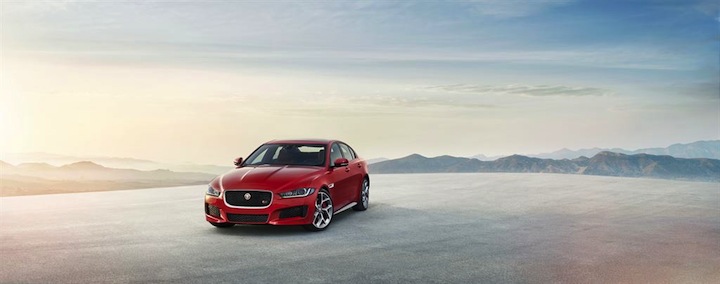
The aluminium-intensive Jaguar XE is the first model developed from Jaguar Land Rover's new modular vehicle architecture and will set the standard for driving dynamics in the midsize segment. The long wheelbase and low seating position enable perfect proportions and a streamlined, coupe-like profile.
The S model's large front air intakes, chrome side vents, discreet rear spoiler and optional 20-inch forged alloy wheels hint at the performance potential of Jaguar's supercharged 3.0-litre V6 petrol engine.
The cabin offers outstanding levels of comfort and spaciousness. Exquisite materials and finishes, combined with traditional Jaguar craftsmanship make this an interior like nothing else in the class.
The XE S will be joined by other models powered by highly efficient 2.0-litre, four-cylinder petrol and diesel engines matched to smooth-shifting six-speed manual and eight-speed automatic transmissions. The diesels - part of Jaguar's all-new Ingenium engine family - provide exemplary fuel consumption and CO2 emissions from 75mpg and 99g/km.
The XE is also the lightest, stiffest and most aerodynamic Jaguar saloon ever built. It is also the first Jaguar to be equipped with electric power steering, tuned to provide exceptional responsiveness and feel but with lower energy consumption than hydraulic systems. The XE boasts the lowest cost of ownership of any Jaguar and is also the most environmentally sustainable.
The aluminium-intensive Jaguar XE is manufactured at Jaguar Land Rover's Solihull plant in an all-new purpose-built facility. Part of a £1.5bn investment, this highly flexible, state-of-the-art manufacturing site will create 1,700 UK jobs.
The XE now completes the Jaguar saloon car range sitting below the XF and XJ models.
Full details of the entire XE range will be announced at the Paris Motorshow in October.
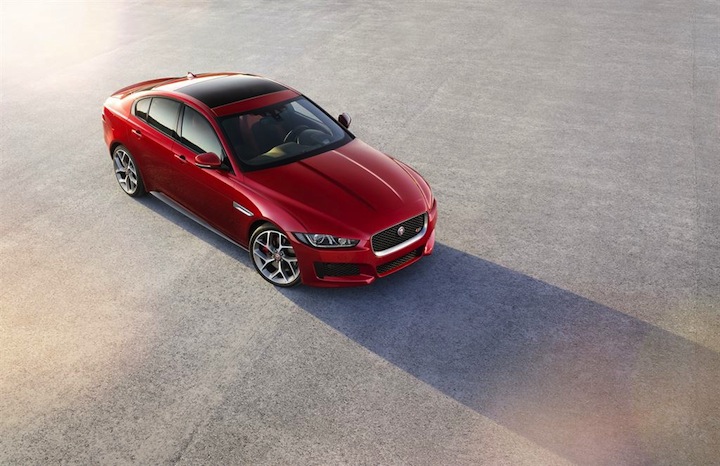
Compelling design: Form and function without compromise
The Jaguar XE was developed in parallel with the new modular architecture. The architecture unlocks design possibilities that did not exist before because the core dimensions were determined by design and engineering working together from the very beginning, under a philosophy of 'anything we can imagine, we can create.'
This makes it possible to realise perfect proportions: short front overhang, longer rear overhang and dynamic, cab-rearward stance. The architecture also enables the XE to feature both a low, sporty driving position and a sleek, coupe-like profile
The strongly-sculpted bonnet creates a taut, muscular appearance. The rising waistline adds to the sense of movement, while the form of the rear quarters takes inspiration from the F-TYPE Coupé. The signature J-Blade running lights are another instantly recognisable Jaguar design element. In the rear lights, a horizontal line intersecting a roundel is a powerful styling feature inherited from the iconic E-type.
Jaguar has a rich history of producing stunning, aerodynamically-efficient cars. The new XE continues the tradition of uncompromised form and function: its streamlined shape has the lowest drag coefficient of any Jaguar yet - just 0.26. This achievement is the result of 1,200 computational fluid dynamics simulations and more than eight million hours of processor time.
"Our mission was to create an exciting and dynamic design clearly reflecting the XE's positioning as a serious driver's car. The cab-rearward proportions and tight packaging achieve that and give the XE the appearance of movement even when it's standing still. It bears a strong family resemblance to the F-TYPE and will stand apart in the crowd."
Ian Callum, Jaguar Director of Design
Expectations created by the XE's exterior styling are more than met once inside. The spacious cabin cocoons front seat passengers with a deep centre console which creates a cockpit-like feel. The F-TYPE-style dials and the cluster needle sweep on start-up further emphasise the XE's sports saloon attributes.
Front and rear seat occupants enjoy generous amounts of head and legroom - the XE proves that sleek, streamlined styling and interior space need not be mutually exclusive. Technical fabrics, fine-grain leathers and details such as contrasting twin-needle stitching give the cabin a bespoke quality. The choice of gloss black, textured aluminium, and contemporary wood veneers enhance the luxurious, hand-crafted feel. Ambient lighting in a range of up to 10 colours adds to the sense of occasion.
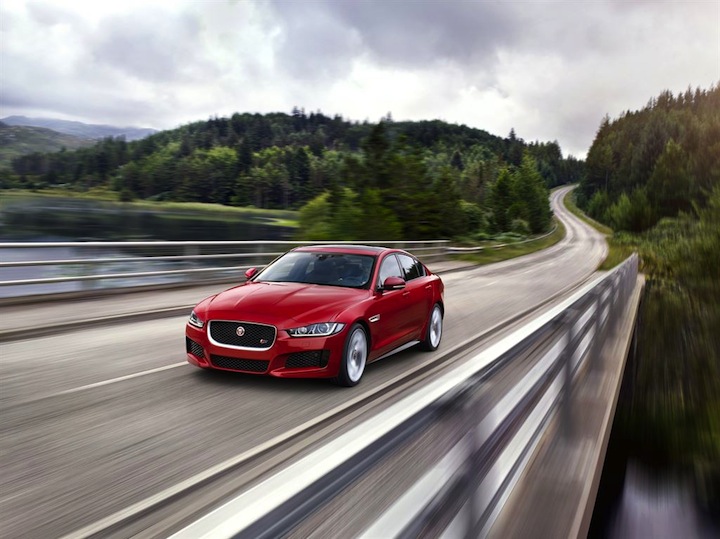
Aluminium-intensive monocoque: Light, stiff, safe
Jaguar is more experienced in the use of aluminium construction than any other vehicle manufacturer. The unrivalled expertise in working with this lightweight material has culminated in the revolutionary body structure of the new XE. It is the first model designed around Jaguar's all-new modular architecture and is the only car in the class to use an aluminium-intensive monocoque.
Much of the aluminium is high-strength, 6000-series alloy. The bodysides are a perfect example: these complex pressings are formed in one piece, and what would once have been 1.5mm gauge sheet has been reduced to just 1.1mm - with no loss of stiffness.
The new XE has been engineered to meet the most stringent legislative and consumer crash test requirements worldwide, including US and Euro NCAP. The deployable aluminium bonnet ensures high levels of pedestrian impact protection.
Sustainability is a big part of Jaguar's aluminium story. Recycling this highly valuable material delivers impressive savings in overall CO2 emissions and the new XE is the first car in the world to use RC 5754 - an aluminium alloy made predominantly from recycled material. Future models will also use RC 5754 and this breakthrough will help Jaguar towards its goal of using 75 per cent recycled material by 2020.
"The XE is as strong and light as it could possibly be thanks to exhaustive analysis and by bringing the latest engineering techniques to bear on its design. It has been challenging to accomplish but the XE's structure is absolutely at the cutting edge of what is achievable today."
Dr Mark White, Jaguar's Chief Technical Specialist; Body Complete
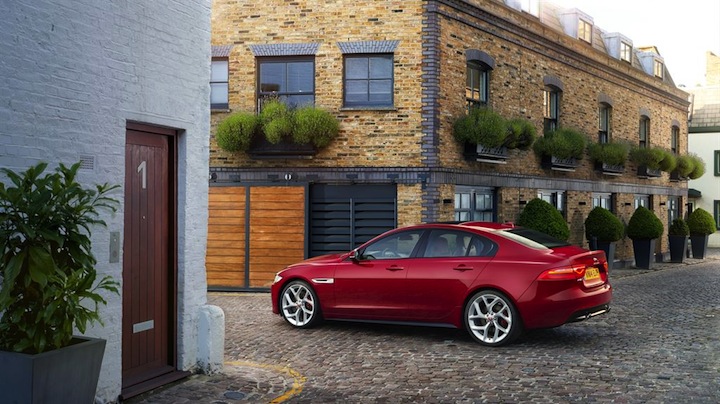
Chassis: Agile, responsive, supple
The new XE has the most sophisticated chassis of any vehicle in its class and will set the benchmarks for ride and handling: it is a true driver's car. Where most competitors use MacPherson strut front suspension, Jaguar's vehicle dynamics team insisted on the superior double wishbone configuration. The aluminium front knuckles are as light as they are stiff and are forged from cast blanks using a patented production process.
Conventional multilink rear suspension couldn't deliver Jaguar's dynamics targets. The solution was Integral Link: a system usually found only in larger, more expensive vehicles and which delivers the ideal lateral and longitudinal stiffness values needed for the XE's precise handling and supple ride. Aluminium has been used extensively, minimising weight.
Electric power steering (EPAS) offers incredible tuning potential and greater energy efficiency than traditional hydraulic systems but Jaguar's engineers have not considered the technology sufficiently mature - until now.
Prototype development using larger vehicles convinced the dynamics team that the best EPAS technology could now deliver the advantages of fuel consumption reduction without any loss of feedback through the steering wheel. The XE is the first Jaguar to use EPAS. As well as reducing CO2 emissions by up to three per cent, the system offers the performance that Jaguar's engineers demanded.
"The introduction of electric power steering was a big step but one we were able to take confidently. The almost infinite range of possibilities it provides in fine tuning has enabled us to achieve the responsive, connected steering feel we require in a Jaguar - without compromise."
Mike Cross, Chief Engineer, Vehicle Integrity, Jaguar
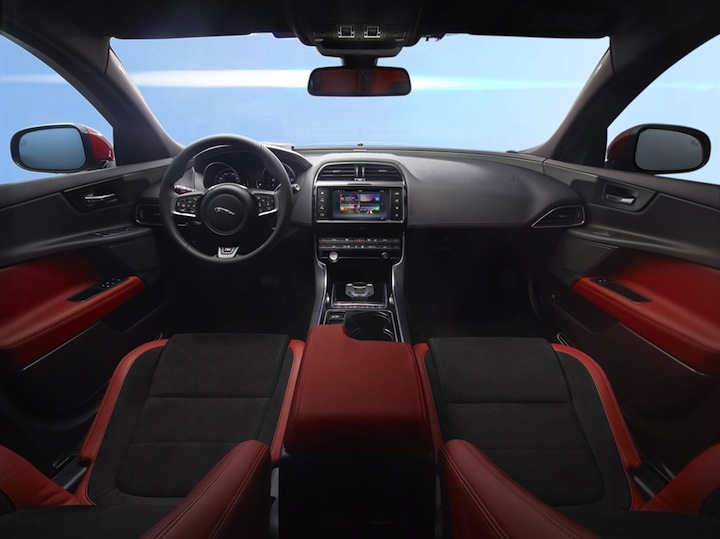
Active safety: Intelligent technologies to support the driver
The new XE's light, stiff bodystructure has been engineered to meet the most demanding legislative and consumer crash test requirements worldwide. Complementing the outstanding levels of protection it offers is a suite of advanced driver assistance systems designed to help and support the driver, making every journey safer, more relaxing and even more enjoyable.
The XE is the first car in the world to be equipped with All Surface Progress Control (ASPC). This all-new system, developed with the input of decades of Jaguar Land Rover experience in off-road traction systems, works like a low-speed cruise control. ASPC functions between 3.6km/h and 30km/h: by precisely controlling the brake system and the powertrain it delivers optimum traction in the most slippery conditions without skidding and without the driver using the pedals.
Projecting high-contrast colour images onto the windscreen, the laser head-up display (HUD) technology provides the driver with information such as speed and navigation instructions with maximum clarity and minimum distraction. As well as superb image quality, the laser HUD is smaller and almost a third lighter than existing systems.
Jaguar is one of the first manufacturers in the segment to use stereo camera technology. This state-of-the-art sensor is the 'eyes' of the XE's autonomous emergency braking system, providing highly accurate measurements of speed and distance of objects ahead, and can initiate full braking to avoid or mitigate a collision.
The stereo camera performs traffic sign recognition and lane departure warning functions too. The XE also offers systems such as adaptive cruise control, closing vehicle sensing, blind spot monitoring, semi-automated parallel and bay parking, and reverse traffic detection.
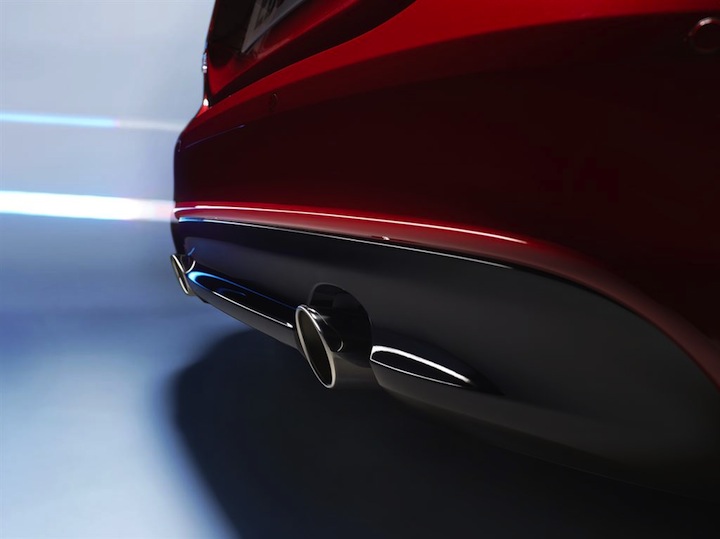
Better connected: All-new infotainment system
The XE's all-new InControl infotainment system offers the latest technologies to connect car, driver and the outside world. At its heart is an eight-inch touchscreen featuring a clear, intuitive graphical interface and fast response times.
Voice control using plain speech gives access to any level of the system, without navigating through menus, so drivers can keep their eyes on the road. InControl's SD card-based navigation allows easy upgrades of map data. The system also supports Bluetooth, audio streaming and USB connectivity.
Smartphones are changing the way people interact with the world around them so the new XE ensures that drivers always stay connected. The car functions as a Wi-Fi hotspot, enabling multiple devices to connect to the internet - the vehicle antenna provides the best possible signal.
Jaguar InControl Remote functionality allows users of iOS and Android smartphones to connect to the car from wherever they are and control a range of vehicle functions. These include seven-day timed pre-setting of the XE's climate control system, locking or unlocking the doors, or starting the engine. Jaguar InControl Apps allows users to seamlessly access smartphone apps through the vehicle's touchscreen.
"For up-to-the-minute parking information, to conference calls, hotel bookings to traffic warnings, InControl Apps can all be accessed with a touch of the screen. Simplifying your connected experience without compromising your interactive options: the new XE is a technologically-advanced step you'll want to take."
Dr Mike Bell, Jaguar's Global Connected Car Director
For drivers who just want to sit back and enjoy the music, the new XE brings Meridian audio technology to the segment for the first time. These superb systems are the latest product of the long-standing partnership between Jaguar and British audio experts Meridian and were developed specifically for the new XE. Unique algorithms guarantee the best possible sound reproduction and tailor the experience to the interior's acoustics.
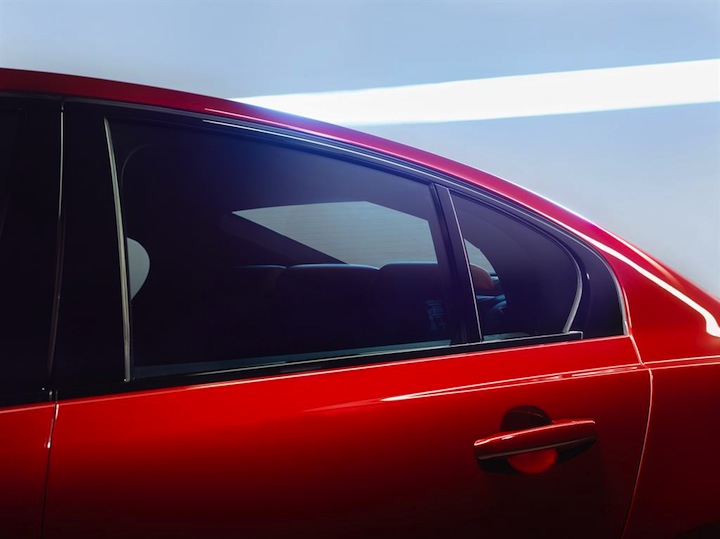
Powertrains: Smooth, refined, efficient
The new XE is powered by a range of four- and six-cylinder all-aluminium petrol and diesel engines offering an impressive blend of performance, refinement and fuel efficiency with a breadth of capability.
For customers demanding ultimate performance and an exhilarating engine note from idle right up to the redline there's the XE S, which shares its supercharged 3.0-litre V6 with the acclaimed F-TYPE.
Spray-guided direct injection and fully variable valve timing optimise power and torque throughout the rev range. The 90° cylinder bank angle provides space for the twin-vortex Roots-type supercharger, a balancer shaft ensures smooth running.
Developing 340PS/450Nm, the V6 provides the XE S with exceptional acceleration and performance: 0-60mph takes just 4.9 seconds, and top speed is electronically-limited to 155mph.
Jaguar is launching the XE with a new family of world-class engines - Ingenium. This advanced in-house modular design began from a clean sheet and is manufactured at Jaguar Land Rover's new £500 million UK Engine Manufacturing Centre.
Proven over 2 million miles of real-world testing, Ingenium is the cornerstone of Jaguar's future low-CO2 powertrain strategy and is engineered to deliver benchmark fuel efficiency, refinement and performance. It will also meet the most stringent exhaust emissions legislation worldwide.
The first Ingenium engines to come off the line are 2.0-litre four-cylinder diesels. Clean combustion, variable exhaust valve timing and sophisticated exhaust gas aftertreatment ensure Euro 6 compliance and take the XE's CO2 emissions as low as 99g/km in the case of the 163PS/380Nm variant. More powerful versions will be available too, combining exceptional fuel economy and even greater responsiveness.
"Ingenium is a new family of compact, lightweight, low-friction, low-emissions engines that will deliver both the efficiency and performance that our global customers desire. Ingenium will make the new XE the most fuel efficient Jaguar ever - and the greenest."
Ron Lee, Jaguar Land Rover Group Chief Engineer, Powertrain
The 2.0-litre turbocharged direct injection petrol engines are powerful and refined and generate strong torque from low speeds, ensuring excellent launch performance and mid-range response. Two ratings will be available in the XE, and both will be offered with a lighter version of the ZF 8HP automatic used in the rest of the Jaguar range: this benchmark eight-speed transmission is controlled using Jaguar's unique rotary shift selector.
Ingenium diesels will also be available with a highly efficient six-speed manual - low viscosity oil and pseudo dry-sump lubrication cut parasitic losses. All of the XE's transmissions are characterised by exceptionally smooth, quiet shifts.
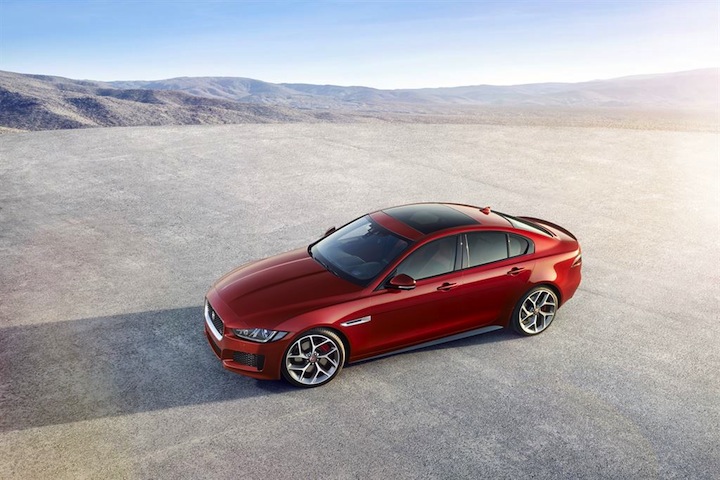
An attractive business case: Sustainable, affordable
The new XE is not only the most fuel efficient Jaguar ever made, it's also one of the most cost-efficient cars in its class. With CO2 emissions as low as 99g/km, the XE attracts low levels of vehicle taxation in many countries - and is even exempt in others.
Jaguar Land Rover is on track to meet its 25 per cent reduction in fleet average tailpipe CO2 emissions - and the new XE is an integral part of this strategy - but the focus on sustainability goes much further.
Riveting and bonding the XE's lightweight bodystructure consumes less energy than traditional spot welding. And the use of recycled aluminium - in particular the new RC 5754 grade - reduces demand for primary aluminium, saving even more energy. The XE also contains 46kg of recycled plastics and renewable materials, reducing its environmental impact still further.
As well as exceptional fuel efficiency the XE's Ingenium diesel engines also achieve a remarkable 21,000 miles or two years between services. From the very beginning, key components were designed to be easily accessible to minimise scheduled maintenance and repair costs. This helps the XE to be awarded highly competitive insurance group ratings.
Full details of the entire XE range will be announced at the Paris Motorshow in October.
New Jaguar XE First Pics!
First Images of the all new Jaguar XE which will be released later tonight Australian time...
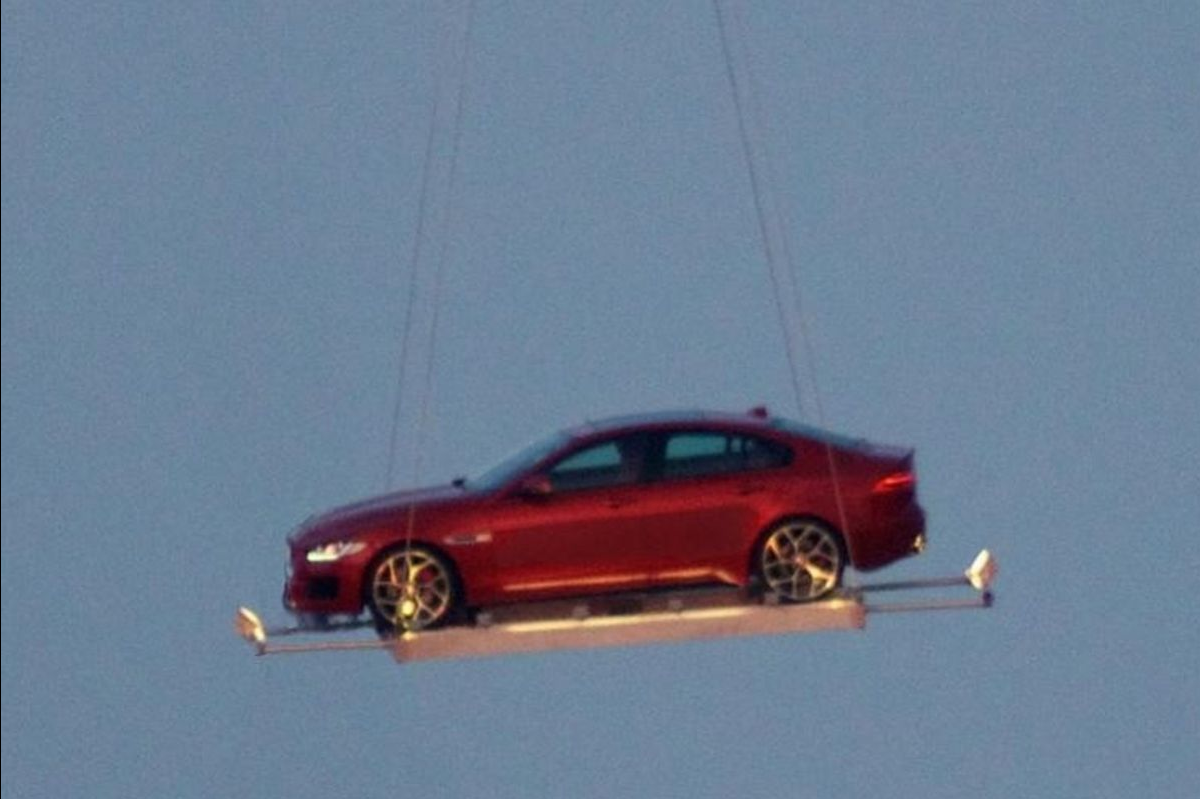
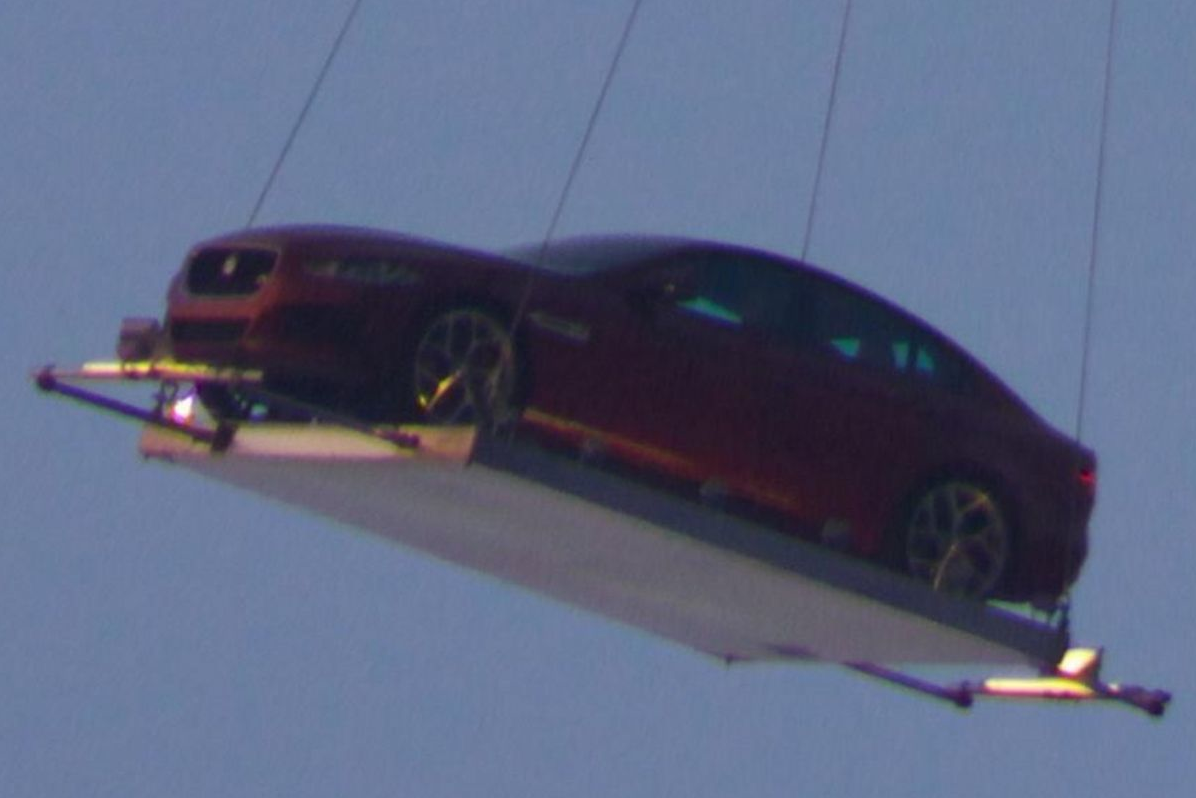
Jaguar's 'Perfect Ten': most important and iconic Jaguar cars
Expert motoring fans including Brian Johnson of rock band AC/DC, Goodwood's Lord March and Jaguar's Director of Design Ian Callum have chosen their 'perfect ten' - the most important and iconic Jaguar cars of all time. The list comes ahead of the worldwide reveal of Jaguar's all-new sports saloon, the Jaguar XE.
The Perfect 10 includes:
1. SS100: Jaguar’s first 100mph production car.
2. XK120 - registration NUB 120: Perhaps the most famous XK120 in the world. Driven by Ian Appleyard and Pat Lyons (daughter of Sir William Lyons) to numerous rally wins in the 1950s, including the Alpine Rallye des Alpes in 1950 and 1951.
3. C-type, registration NDU 289: Original entry in the 1953 Mille Miglia, and one of just 54 cars built.
4. D-type, registration 393 RW: This penultimate D-type won the 12 hours race at Reims driven, by Hamilton and Bueb, and was sixth at Le Mans with the same driver pairing.
5. MK II: A great example of the legendary sporting saloon for which Jaguar has become globally renowned, and the genesis of the brand-new XE.
6. E-type, registration77 RW: The Jaguar ‘Works’ press car, famously driven overnight by Norman Dewis to Geneva for its Motor Show debut to great fanfare. This was the first production Jaguar to reach 150 mph, and is the earliest surviving E-type Roadster
7. XJ13: Only one example of this car was built, being the first Jaguar to use the V12 engine. The XJ13 was built for - but never raced at - Le Mans, and was designed by Malcolm Sayer.
8. XJ6 S1: Car of the Year when launched in 1968, this particular XJ6 was Sir William Lyons’ personal car.
9. TWR XJS: Tom Walkinshaw was very successful in motorsport for Jaguar in the 1980s and returned Jaguar to the podium with the racing version of the legendary XJS winning the European Touring Car Championship.
10. XJR-9. Tom Walkinshaw won Le Mans in 1988 with this very car, in one of Jaguar’s seven victories in the famous endurance race
Jaguar Reveals 'New' Lightweight E-type
Jaguar has revealed the prototype of its 'new' Lightweight E-type - a further six of which will be built and sold.
Jaguar announced in May 2014 that it would recreate six new Lightweights, each built by Jaguar Heritage, part of Jaguar Land Rover's new Special Operations division.
Each of the six cars will be built to a specification originated from the last Lightweight E-type produced in 1964 and will be hand-crafted at the original home of the E-type, Jaguar's Browns Lane plant in Coventry, England. The cars will be sold as period competition vehicles and all will be suitable for FIA homologation for historic motorsport purposes.
The new cars are the 'missing' six vehicles from the 'Special GT E-type' project, which originally started in February 1963 with the objective of building 18 cars. Only 12 of the aluminium-bodied Lightweight E-types were eventually built and the remaining six designated chassis numbers having lain dormant, until now. The six new cars will carry those original, historic Lightweight E-type chassis numbers.
A race winner in the hands of a variety of famous drivers during its short competitive career, the car has achieved worldwide fame and original examples are now valued in the many millions. In recreating the Lightweight E-type, Jaguar Heritage has been able to call on the superlative skills and experience of many talented engineers and technicians already working in a variety of departments within Jaguar.
All, when offered the chance to assist with this unique project, leapt at the opportunity. Some even have an indirect link with the E-type when it was new: one master technician calculated that his family - including his grandparents, his father and his uncle - had a collective 170 years' service at Jaguar stretching back to the early 1960s.
The expertise and attention brought to bear on this recreation project is staggering, with the full resources of Jaguar being applied to ensure that the six new Lightweights will not only be authentic, but will also be built to the highest quality standards.
So the six chosen customers will each receive the rarest of things - a brand new Lightweight E-type, hand-built at Browns Lane and just as desirable as one of the originals.
"Operating from a brand new workshop at Browns Lane - now open for the restoration and servicing of customer cars - the building of six new, meticulously crafted Lightweight E-type period competition cars by Jaguar Heritage is testament to the unique skills within the team. To know those same skills can also be utilised to the benefit of existing classic Jaguar owners means this is a very exciting time for Jaguar Heritage."
Derek Weale, Director, Jaguar Heritage Business

THE LIGHTWEIGHT E-TYPE PROJECT IN DETAIL
Engineering
The bodyshell
The core component of the Lightweight E-type is its aluminium bodyshell. This material replaced the steel of the production E-type in the quest to shed weight - some 250lb (114kg) were saved compared with the standard car.
Despite the 50-year gap, the aluminium build of the six new Lightweights gives them an immediate affinity with the current Jaguar range, the F-TYPE and XJ models being built to exacting standards with aluminium bodies for exactly the same reason. In fact, Jaguar is now the world's leading manufacturer of aluminium-bodied cars and the company has unrivalled experience in the relatively new field of applying aluminium technology to volume production cars.
So when tasked with the job of recreating the Lightweight E-type's aluminium body, today's Jaguar engineers could relate at once to what their predecessors had achieved 50 years before. However, despite the enormous advances in technology since the early 1960s, the decision was taken not to incorporate modern materials or fixing methods. While high-strength aluminium alloys and bonded structures would have been invisible, they would not have been true to the original design - and nor would they have conformed to the FIA's homologation requirements for historic racing.
Instead, today's advanced technology was deployed to ensure the highest quality and most faithful rendition of the Lightweight E-type's open two-seater body components. Using state-of-the-art scanning technology, the inner and outer surfaces of a Lightweight bodyshell were digitally mapped.
The resulting massively detailed scan, which recorded dimensions and shape down to a fraction of a millimetre, was then assessed by Jaguar's technicians to validate how the body was assembled back in the 1960s, how consistent the structure was side-to-side, and how it could be engineered today to produce the highest quality result for the Lightweight E-type project.
As this digital capturing process gave Jaguar's engineers complete control over the Lightweight E-type body's 230 individual components, their shapes could then be optimised before the data was sent to the tool room at Jaguar's Whitley engineering centre. Even panels which are unseen within the structure have been faithfully reproduced. To ensure absolute symmetry, one side of the scanned body was used as the datum, this being 'flipped' to produce an identical condition on the opposite side.
Additionally, before being signed-off, the outer 'A-surface' CAD scan was transferred to Jaguar's design department where the surface geometry was finalised. All this work ensured that the tooling from which the majority of the new body parts are produced is as accurate as possible.
Approximately 75 per cent of the panels are made in-house at Whitley, just a few very large pressings being supplied by external specialists using Jaguar-designed tooling. The grades of aluminium used for both the under-structure and surface panels are almost identical in mechanical properties to those used for the original 1963 Lightweight E-types. The body is completed to original Lightweight E-type Chassis no. 12 condition, by which time Jaguar had added some additional strengthening in key areas of the shell. The aluminium body is then completed by the addition of an aluminium bonnet, doors and trunk lid. As with the original cars, an aluminium hard top is standard.
The development of the body-in-white tooling was undertaken by the same department that builds all Jaguar Land Rover prototype vehicles, so the expertise applied to the project was world-class. The build process and assembly procedures were initially proved out on Car Zero; this is effectively an engineering prototype and will not carry one of the six Lightweight chassis numbers.
For the Lightweight E-type project, Jaguar's engineers created a 'grey book' of the type used during the development of new production Jaguars. This internal document sets out the required quality standards in terms of bodyshell fit-and-finish and ensures a consistency of build quality for all six new Lightweight E-types.
A roll-over cage is fitted as standard, and the body includes mounting points for a detachable front extension which is available as an extra. The cars are built in a form suitable for FIA homologation for historic motorsport purposes.

The engine and drivetrain
The Lightweight E-type was powered by a highly developed version of Jaguar's straight-six XK engine which, with its chain-driven twin overhead camshafts and aluminium head with hemispherical combustion chambers, remained highly advanced in 1963 even though it had first been seen in the XK 120 as far back as 1948.
It was this engine that had powered the C- and D-types to five Le Mans victories in the 1950s, and the unit developed for the Lightweight E-type is based on the 3,868cc (236 cu in) engine which, in the D-type, had won Le Mans in 1957. A similar big valve 'wide angle' cylinder head is used, but in place of the D-type's cast iron block, Jaguar introduced an aluminium block for the Lightweight E-type which substantially reduced the amount of weight over the front wheels. This also features in the present-day car, with pressed-in steel liners.
Another major feature transferred from the D-type is the dry sump lubrication system. This uses a scavenge pump to collect oil from the sump and return it to a separate oil tank in the underbonnet area. This eliminates oil surge during fast cornering and consequent risk of damage to the engine's bearings, and also allows a greater quantity of oil to be carried.
The compression ratio is 10:1 and today's car is supplied with three 45DCO3 Weber carburettors. These were homologated by Jaguar for the Lightweight E-type in addition to a Lucas mechanical fuel injection system - which is being offered to customers as a cost-option (and which is fitted to Car Zero). The exhaust manifold is a steel fabrication and leads the exhaust gasses into twin pipes which take them through a centre silencer box to the rear of the car, where the exhaust system ends in twin polished tail pipes.
Whether carburettors or fuel injection is specified, brake horsepower is well over 300, and with torque in the region of 280lb ft at 4500 rpm, the car is endowed with rapid acceleration from comparatively low engine revs - a traditional feature of Jaguar racing engines.
A 12 volt negative earth electrical system is used, and the engine benefits from a modern inertia-type starter motor. The water and oil radiators are in aluminium alloy, there is an aluminium expansion tank for the coolant, and the fuel tank is mesh-filled for safety.
The power is transferred to the road via a lightweight, low inertia flywheel, a single-plate clutch and a Jaguar close-ratio, manual four-speed all-synchromesh gearbox as used by the Lightweight E-type in period. A variety of final drive ratios are available, all with the Powr-Lok limited-slip differential, but a 3.31:1 ratio is supplied as standard.

Suspension, steering and brakes
The twin wishbone front suspension and independent wide-based wishbone rear suspension (where the drive-shaft serves as the upper link) are set-up according to period racing practice, with uprated shock absorbers controlling the torsion bar springs (front) and the four coil springs (rear).
The steering is the excellent standard E-type rack-and-pinion, with a traditional wood-rim wheel for the driver. Larger (12.25in) brake discs are fitted at the front, with the rear brakes being standard E-type. No servo is fitted.
The 15in diameter wheels are period type in the correct 'perforated' style, and like the originals are cast in magnesium alloy. Rim width is 7in front, 8in rear. Dunlop racing tyres are fitted, 6.00 section front, 6.50 section rear, both in CR65 compound.

Final assembly
The monocoque bodyshell is built at Whitley where it is mated to its tubular engine sub-frame - which is stiffened with gussets as for the original Lightweight - and then shipped to Jaguar's Gaydon facility for painting. From there it is then taken to Jaguar Heritage at Browns Lane where the car is built up with powertrain, suspension, brakes, steering, electrical items, instrument panel and soft trim.
This process takes place in a dedicated area close to where the original Lightweight E-types were assembled in 1963/64, and the work is undertaken by highly skilled technicians used to assembling extremely complex JLR prototypes.
It is at this stage that personal consultation with the customer dictates the final specification for each individual car - no two of which are expected to be identical.
Car Zero underwent a 15-day shake-down period at Jaguar Land Rover's test facility at Gaydon to prove out the car's dynamics and establish optimum suspension settings. This involved Mike Cross, Jaguar's Chief Engineer, Vehicle Integrity. Jaguar's engineers even established a 'design verification plan' for the car, just as they would do for an entirely new model. Each of the six new Lightweights will go through shake-down tests to ensure that they meet the required standards in terms of braking, handling and steering.
"In our contemporary Jaguar sports cars our aim is always to achieve an immediacy of response to all driver inputs - and the goal with Lightweight E-type was the same. For me, its response to steering, brake and throttle inputs - along with the terrific noise it creates - is what makes it such an engaging machine from the driver's seat."
Mike Cross, Chief Engineer, Vehicle Integrity, Jaguar

Design
Jaguar's Advanced Design Studio has been involved in the project from an early stage, charged with arriving at the appropriate level of trim for the new car, together with selecting the materials used and the nature and colour of finishes.
"With the Lightweight E-type, our focus as a design team has been to ensure justice was done to the original work of Sir William Lyons and Malcolm Sayer. Meticulous attention to detail has been everything to us in re-creating this car, just as it is in our contemporary Jaguars. I believe the result is a new Lightweight E-type that is as stunning now as the originals would have been when they were new."
Ian Callum, Director of Design, Jaguar
Connolly leather is used, supplied by Jonathan Connolly with hides produced to the same specification as those used by Jaguar in the 1960s. This leather is used to trim the competition-type aluminium bucket seat base. The centre console covering is also leather, and there is a choice of seven trim colours.
As befits a thoroughbred GT car where weight saving in all areas is demanded, interior trim is minimal. However, the customer can opt for a more fully-trimmed car and the Jaguar team can devise bespoke trim packages. This may include door cards, headliner for the hardtop, removable custom saddle-leather floor mats, and a cover for the transmission tunnel.
Much of Car Zero's interior - floorpan, sills, rear areas - have intentionally been left unpainted, to emphasise the car's aluminium bodywork.
The studio has also selected a palette of six 'heritage' paint colours recommended for the exterior: Carmine red, opalescent grey metallic, silver metallic, opalescent blue metallic, British racing green, Old English white. However, various colour and trim alternatives are available, as each car is built to the personal specification of each individual customer, who can discuss options with Jaguar's Director of Design, Ian Callum, in person.
In celebration of the new Lightweight E-types, Jaguar has also furthered its relationship with the Bremont Watch Company. Bremont will create six bespoke 'E-type' watches, each of which will be offered to customers of the six new Lightweight E-types.

LIGHTWEIGHT E-TYPE SPECIFICATION*
Engine System
Engine: Aluminium six-cylinder block, wide-angle cylinder head, dry sump lubrication, lightweight low-inertia flywheel
Displacement: 236.0 cu in (3,868cc)
Bore/Stroke: 3.46in/4.17in (88.0mm/106.0mm)
Valvetrain: 2 valves per cylinder, DOHC
Compression ratio: 10:1
Carburettors: Triple 45DCO3 Weber
Injection (optional): Lucas mechanical, 6.25in (158.7mm) butterfly trumpets
Crankshaft: Steel with steel H-section con rods
Power: 340hp/253.5kW @ 6500rpm
Torque: 280lbs ft/380Nm @ 4500rpm
Fuel tank: Mesh-filled 14-gallon (64-litre) capacity
Fuel pump: Standard E-type
Transmission and Driveline
Transmission: Jaguar 4-speed all-synchro close-ratio gearbox
Final drive casing: Cast iron, Powr-Lok limited slip differential, axle ratio 3.31:1
Gearbox oil: Castrol
Clutch: Single dry plate
Suspension and Steering
Front: Double wishbone, LWE torsion bars, uprated anti-roll bar
Rear: Jaguar independent rear suspension lower wishbones/driveshaft links, radius arms, anti-roll bar (C/O Standard E-type rear springs with uprated damper assemblies)
Steering: Standard E-type rack-and-pinion, adjustable steering column
Brakes
Brake discs (front): 12in Dia (305mm)
Brake discs (rear): 11.25in Dia (286mm)
Handbrake: Production E-type
Wheels and Tyres
Magnesium disc wheels: Front: 15in x 7.0J, Rear 15in x 8.0J
Tyres: Dunlop (Front - 6.00L15 CR65, Rear - 6.50L15 CR65)
Electrical
Battery: 12v - 62 amp / hour
System: 12v negative-earth
Lighting: Tungsten headlamps and standard rear tail-lamps
Ignition: Electronic
Instruments: Smiths Industries
Generator: Production E-type
Starter: Production E-type
Control Box: Production E-type
Wiper motor and blades: Production E-type
Exhaust and Cooling
Exhaust: Fabricated steel manifold, steel exhaust system with centre silencer box and twin polished tail pipes
Cooling: Aluminium E-type radiator, aluminium expansion header tank, engine oil cooler, oil sump tank
Overview
Length: 175.3in (4,453mm)
Width: 66.9in (1,700mm)
Height: 46.5in (1,181mm)
Weight: 2204.6lbs (1,000kg)
Wheelbase: 96.1in (2,440mm)
Front Track: 50.0in (1,270mm)
Rear Track: 55.0in (1,397mm)
BODY TRIM & HARDWARE
Body in white & closures
Aluminium monocoque with stiffened front sub-frame for race engines above 300bhp
Riveted and welded aluminium construction
Aluminium body closures (bonnet/doors/trunk-lid)
Aluminium detachable hard top roof
21 louvre bonnet air intakes
Black powder-coated roll cage
Front brake cooling ducts integrated with bonnet structure
Exterior trim
- Side bonnet-release handles
- 'Long range' aluminium quick release fuel cap
- Body colour cabin ventilation air intakes
- Protective car cover (non-waterproof)
- Centre bonnet catch
- Oval door mirror upgrade
Interior Trim
- Aluminium bucket seats with increased backrest angle and padded cushions
- Rear-view mirror
- Leather selection from Connolly palette
- Wood-rimmed steering wheel
- Aluminium gear knob and standard hand brake
- Machined metal toggle and push button starter
- Five-point seat belt
- Black instrument panel with glove box
- Bonnet and boot stands
Glass house
- Clear laminated front screen
- Perspex side windows and rear screen
- Manual slide side windows
*Figures are manufacturer's estimates, subject to change according to customer specificatio
Purr-fect!
Jaguar Land Rover Special Operations Strengthens Heritage Business with Acquisition of British Classic Car Collection
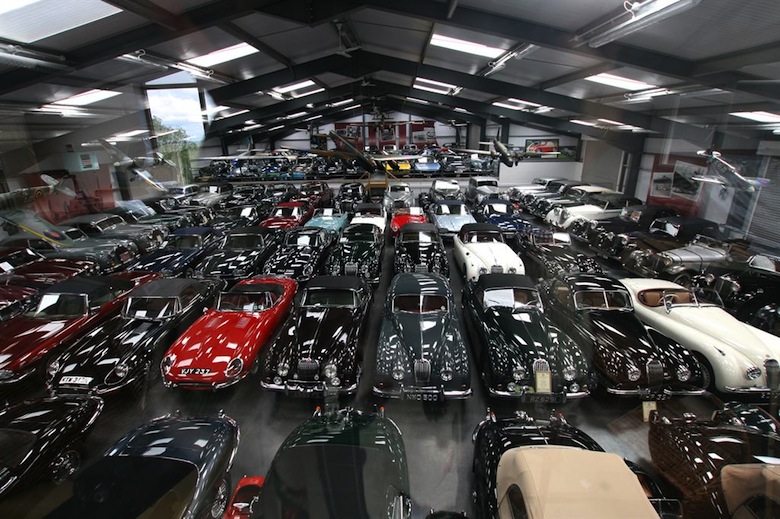
Jaguar Land Rover has today announced that it has purchased the largest privately owned collection of British cars. The collection assembled over many years by British enthusiast James Hull, includes 543 mostly British classic cars and features many significant Jaguar models including XK SS, C, D and E-types. The acquisition underscores Jaguar Land Rover's increased support and focus on heritage. The cars in the collection will be actively used to support brand and experiential marketing to develop the brands and business in existing and emerging markets.
The collection which has been painstakingly assembled and restored by James Hull, British car enthusiast, entrepreneur and philanthropist, has at its core over 130 Jaguars. These include early Swallow Sidecars and Swallow coachbuilt Austin Sevens, plus a full and diverse range of pre-war SS models, 7 XK 120s - including a rare alloy-bodied example, C- and D-types, an XKSS, 8 E-types, 30 classic Jaguar 'Mark' model saloons plus 19 XJS models and over 20 XJ saloons with interesting and famous previous owners. The majority of these cars are in truly outstanding condition, with many having fascinating histories behind them. The collection also features many other iconic and famous British cars and models.
This acquisition is part of an increased commitment by Jaguar Land Rover to protect and nurture the rich heritage possessed by both brands. It follows the recent creation of Special Operations, which has been established to develop and oversee heritage and the creation of special vehicles, such as the recently announced Jaguar Project 7. The Project 7 is a limited edition F-TYPE, which takes its inspiration from the legendary D-type. The Project 7 name refers to the seven outright Le Mans victories scored by Jaguar and is highly appropriate given this is the 60th Anniversary of the creation of the D-type.
The Jaguar Heritage business, part of Special Operations, recently announced the build of six perfect recreations of the original, race-bred Lightweight E-type that was created in 1963. The new Lightweights will hand-built by highly skilled Jaguar craftsmen in a new Jaguar heritage facility at Browns Lane, less than a hundred yards from where the original cars were assembled in 1963. This new facility will utilise those same skills to offer Jaguar warrantied servicing and restoration of the company's classic models.
The cars in the collection will be actively used to support experiential marketing with customers and for global brand events. A good example of this will be the global launch of the Jaguar XE in early September together with many other events and activities in new and emerging markets. It is in these newly developing markets that heritage can play a key role in establishing and developing the brand.
John Edwards, Managing Director of Special Vehicle Operations commented. "We are delighted that Jaguar Land Rover has come to an agreement with James Hull to secure the future of this very significant collection of Jaguar and British cars. We share the same objective as James to keep this unique collection in British hands and we are delighted this agreement secures their custody for the future. We look forward to continuing to work with James going forward as we develop our heritage activities.
Heritage is becoming an ever more important differentiating factor when it comes to experiential customer marketing and in developing our brands in new and emerging markets. Jaguar and Land Rover have a combined "back catalogue" of over one hundred and forty years to draw upon and some of the most iconic vehicles in the industry. In addition with the explosive growth and interest in classic car events worldwide and the increase in the size and value of the market, there is a strong brand and business rationale underpinning this agreement."
James Hull commented, "Travelling all over the world to build the collection over the years has been a labour of love and a life's work, so my primary motivation was not to get the maximum price but rather to secure the future of the collection in this country with the right custodian. I have got to know Jaguar Land Rover well in recent years and they have borrowed cars from the collection for events such as the Mille Miglia and supporting Jaguar in China. They are the perfect custodians to take the collection forward and I know it is in safe hands."
Jaguar to Build F-TYPE Project 7: The Fastest and Most Powerful Production Jaguar
F-TYPE Project 7, the latest model in Jaguar's acclaimed F-TYPE sports car range, made its debut at the 2014 Goodwood Festival of Speed last weekend 26 June.
F-TYPE Project 7 is the first Jaguar performance vehicle from Jaguar Land Rover's Special Operations team, and will be produced in an exclusive, limited-edition run of up to 250 units. Its distinctive roadster body, introduced in concept form last summer, pays tribute to one of the most famous and iconic racing Jaguars: the three-time Le Mans winning D-type, which in 2014 is celebrating its 60th anniversary year. F-TYPE Project 7's name pays homage to Jaguar's seven outright Le Mans wins.
The 2014 Jaguar F-TYPE Project 7 is not only the most focused derivative of the award-winning F-TYPE range, but is also the fastest and most powerful production Jaguar ever built.
F-TYPE Project 7's power comes from Jaguar's 5.0-litre supercharged V8 engine, now in 575PS/680Nm form, enabling the all-aluminium-bodied car - which weighs 1585kg - to achieve acceleration from 0-60mph in 3.8-seconds (0-100km/h in 3.9-seconds) and an electronically-limited top speed of 186mph (300km/h). F-TYPE Project 7 is fully road-legal, with a removable roof and 196-litre stowage space.
Power is sent to the rear wheels through Jaguar's eight-speed Quickshift transmission and second generation Electronic Active Differential (EAD). Carbon Ceramic Matrix (CCM) brakes, available as an option on the F-TYPE R Coupé, are fitted as standard on F-TYPE Project 7, offering powerful, consistent, fade-free braking. Another standard feature is Torque Vectoring by Braking (TVbB) which, working in conjunction with the EAD, enables extremely precise handling. Bespoke carbon-fibre aerodynamic aids and a unique suspension set-up enable F-TYPE Project 7 to deliver a truly engaging driving experience.
While F-TYPE Project 7 features performance-focused engineering by Special Vehicle Operations - the engineering and vehicle division of Special Operations - its design has been kept true to the head-turning lines of the original Project 7 concept, which was unveiled last summer.
Key design elements include the D-type-inspired fairing behind the driver's head, shorter windshield, new front bumper, and downforce-increasing aerodynamic modifications - including a carbon-fibre front splitter, side skirts, rear diffuser and adjustable rear spoiler. However, the single-seater concept has been transformed into a two-seater, with rollover hoops for both driver and passenger now integrated into the design.
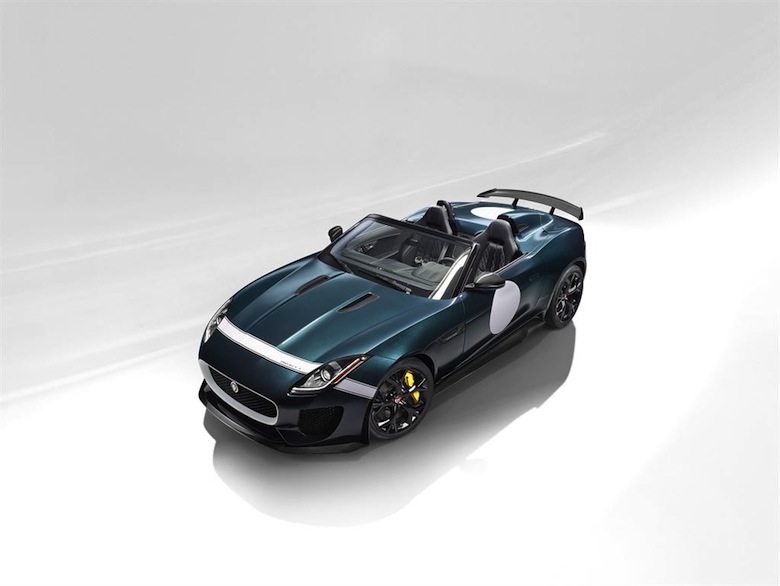
2014 JAGUAR F-TYPE PROJECT 7: IN DETAIL
Engineering
The 2014 Jaguar F-TYPE Project 7 is a product of pure passion, and the pinnacle of Jaguar's performance sports car range. The most focused derivative of the highly acclaimed F-TYPE range, it is the fastest and most powerful production Jaguar ever made.
The Special Vehicle Operations-engineered F-TYPE Project 7 is powered by Jaguar's 5.0-litre supercharged V8 engine, as seen in the F-TYPE R Coupé, but in an even further enhanced form: it produces 575PS (an increase of 25PS over the F-TYPE R Coupé) and 680Nm of torque. Power is delivered to the rear wheels through Jaguar's eight-speed Quickshift transmission and second-generation Electronic Active Differential. Special Vehicle Operations engineers have developed a bespoke transmission calibration for the F-TYPE Project 7, with revised shift points and characteristics.
This enables the lightweight, all-aluminium bodied roadster - which, at 1585kg, weighs 80kg less than the F-TYPE V8 S Convertible - to accelerate from 0-60mph in just 3.8 seconds (0-100 km/h in 3.9 seconds), with an electronically-limited top speed of 186mph. The increased performance, combined with the handling and aerodynamic enhancements, make F-TYPE Project 7 the new benchmark in high-performance Jaguars.
F-TYPE Project 7 features a switchable Active Sports Exhaust system with quad, matt-black ceramic coated, outboard-mounted tailpipes. The system uses electronically-controlled bypass valves in the rear section of the exhaust which are mapped to open according to a range of parameters, effectively altering the exhaust gas routing into a free-flowing straight-through arrangement to both reduce back pressure and enhance sound quality.
F-TYPE Project 7 rides on 20-inch Storm alloy wheels in gloss black, which customers can opt to have fitted with high-performance Continental ForceContact tyres. Carbon Ceramic Matrix (CCM) brakes - with 398mm front and 380mm rear discs allied to six- and four-piston monobloc calipers respectively - are fitted as standard.
Made from a matrix of carbon-fibre and ceramic, which is extremely hard and highly resistant to wear, the CCM system offers consistent performance and excellent fade resistance even during sustained extreme driving conditions. Jaguar's CCM brakes feature a pre-fill system function that applies a low brake pressure to all four calipers when the throttle is released - and before the brake pedal is pressed again - to ensure consistent brake pedal feel.
F-TYPE Project 7 benefits from bespoke, Special Vehicle Operations-engineered front suspension knuckles which give increased negative camber, revised top mounts and new front/rear anti-roll bars. The front and rear spring and damper units are height adjustable, and both spring rates and damper internals have been tailored specifically to F-TYPE Project 7.
Jaguar's Adaptive Dynamics system actively controls vertical body movement, roll and pitch rates by continuously monitoring driver inputs and the attitude of the car on the road, adjusting damper rates accordingly up to 500 times a second to optimise stability. The Adaptive Dynamics controlling software has been precisely re-calibrated to suit F-TYPE Project 7, the Dynamic Stability Control system also having a unique state of tune.
Engaging Dynamic Mode delivers enhanced body control through firmer damping rates, increased steering weighting, faster gear changes and sharper throttle response. Dynamic Mode is configurable as standard via the central 8-inch touchscreen, allowing the driver to select and save settings according to their preference.
Torque Vectoring by Braking (TVbB), which intelligently and rapidly applies precise amounts of braking force to individual wheels to accurately sharpen the car's line through a corner, is standard. TVbB works in conjunction with the Electronic Active Differential (which can go from open to full locking torque in 200 milliseconds) and the car's Dynamic Stability Control system to optimise traction, cornering ability and, most importantly, to maximise steering feel and agility.
"Above all - F-TYPE Project 7 is fast… It uses all the key technologies we've proven on F-TYPE R Coupe to deliver absolute immediacy of response to all driver inputs, yet its focused nature has given us the opportunity to go further still. The result is a driving experience that's pure and involving in every sense."
Mike Cross, Chief Engineer - Vehicle Integrity, Jaguar
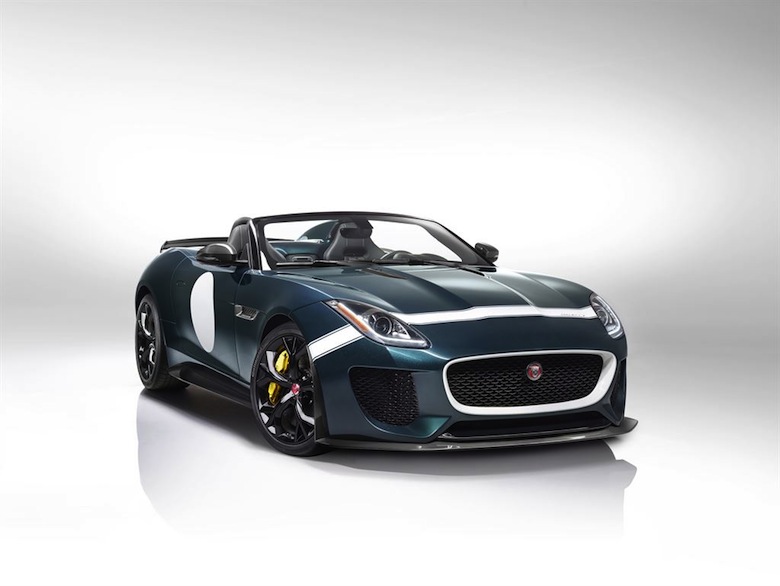
Design
The Jaguar F-TYPE Project 7 retains the distinctive, minimalist design of the original 2013 concept. That design study was penned as a spare-time experiment that blended Jaguar's rich racing heritage with its then-new, groundbreaking sports car line, the F-TYPE. Under Jaguar Director of Design, Ian Callum, the sketch - of a single-seater sports car with a swooping profile, muscular stance and cut-down windscreen - went from paper to digital model to the Goodwood hillclimb in the space of just a few months, and has now become a production car.
"F-TYPE Project 7 is the perfect example of how, as a design team, we can move quickly with our engineering colleagues to go from concept vehicle to production reality - we've pushed the boundaries of what's possible without losing any purity of form.
Modern, purposeful and with a stance that screams intent, F-TYPE Project 7 is the perfect contemporary embodiment of the D-type that inspired it."
Ian Callum, Director of Design, Jaguar
F-TYPE Project 7's key 'heartlines' remain those of the World Car Design Award-winning F-TYPE sports car. They effortlessly blend with the D-type-inspired rear fairing section that incorporates a rollover hoop and swoops rearwards and down from behind the driver's head. Being a two-seater, F-TYPE Project 7 features a second rollover hoop, behind the passenger seat.
Extensive aerodynamic modifications on F-TYPE Project 7 include an all-new front splitter which utilises an upper section in carbon-fibre. Additionally, the side skirts, rear diffuser and adjustable rear spoiler are all made of carbon-fibre. These components together mean F-TYPE Project 7 generates 177% more downforce than F-TYPE Convertible at its top speed of 186mph.
The rear deck, bonnet vents, side vent louvres and mirror caps are also all made of carbon-fibre. The windscreen length is reduced by 114mm, reducing overall height by 30.5mm, with new side windows to match the profile. A Bimini roof has been specially designed for F-TYPE Project 7. It clips on to the convertible header rail, and can be conveniently folded and, when not in use, stowed in the boot area - which offers 196-litres of load space.
The driver and passenger of F-TYPE Project 7 sit in lightweight race-inspired bucket seats, which are finished in a quilted racing-style diamond pattern. Four-point racing harnesses are available as an accessory. The interior features carbon-fibre veneer inserts on the console, an Alcantara steering wheel (with leather option), machined aluminium gearshift paddles and bespoke treadplates with the Project 7 logo.
Enhancing its unique appeal, the 2014 F-TYPE Project 7 will be hand-built to exacting standards by Special Operations, and offered in an exclusive, limited-edition production run of up to 250 units globally. Each car will sport a specially numbered plaque, located between the two seats, signed by Ian Callum.
F-TYPE Project 7, whose name acknowledges Jaguar's seven historic Le Mans race wins, will be offered in five metallic colours: Ultra Blue, Caldera Red, , British Racing Green (all with white decal options), Ultimate Black and Glacier White (both with grey decal options).
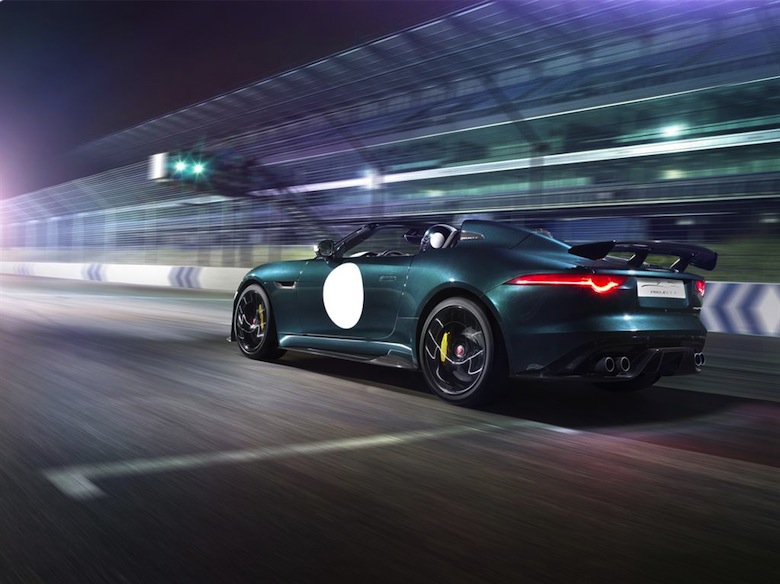
2014 JAGUAR F-TYPE PROJECT 7: TECHNICAL SPECIFICATION*
*All figures are manufacturer's estimates and subject to final confirmation ahead of production
ENGINE & TRANSMISSION
Engine capacity (cc)
5000
Cylinders
8
Valves per cylinder
4
Compression ratio
9.5:1
Bore/stroke (mm)
92.5/93.0
Bore/stroke (inches)
3.64/3.66
Transmission
8-speed 'Quickshift'
PERFORMANCE
0-60mph (sec)
3.8
0-100km/h (sec)
3.9
Top speed (mph)
186, electronically limited
Top speed (km/h)
300, electronically limited
Power (PS@rpm)
575@6500
Power (kW@rpm)
423@6500
Torque (lb ft@rpm)
502@2500-5500
Torque (Nm@rpm)
680@2500-5500
Wheels
20-inch 'Storm' alloy,
in gloss black
Tyres - size
255/35/20 (front)
295/30/20 (rear)
Tyres - make
Standard:
Optional:
Pirelli P Zero
Continental ForceContact
DIMENSIONS
Length (mm)
4519
Length (in)
178
Width excl (mm)
1923
Width excl (in)
75.7
Height (mm, without roof)
1277
Height (in, without roof)
50.3
Wheelbase (mm)
2622
Wheelbase (in)
103.2
Fuel tank capacity (litres)
72
Fuel tank capacity (gallons)
15.8
Weight (kg)
1585
Weight (lbs)
3495
Steve McQueen's 1956 Jaguar XKSS - Jay Leno's Garage
Fantastic story on Jay Leno's Garage where Jay gets an in-depth tour of the King of Cool's "Green Rat."
2015 Jaguar XE V6 spied testing on the Nürburgring
Jaguar has returned to the Nürburgring Nordschleife with two new prototypes of the 2015 Jaguar XE.
Judging by the sound it is running the same engine as the V6 F-Type, rumours suggest the XE will have a four-cylinder engine, but will also be offered in a performance version as well. The performance version is roumerd to have the supercharged 3.0 litre V6 from the F-type, that is what we believe is being tested here.
Remarkable detail is that one of the 2 prototypes had a little incident on the track. At the start of the day it had 2 side mirrors, but later on it was missing one and the camouflage was also a bit damaged.
The Lightweight E-type is Reborn

Jaguar is to build six perfect reproductions of the original, race-bred Lightweight E-type that was created in 1963. The new cars are the 'missing' six vehicles from Jaguar's Lightweight E-type project, which originally started in February 1963 with the objective of building 18 'Special GT E-type Cars'.
Only 12 of the aluminium bodied Lightweight E-types were eventually built, the last in 1964, the remaining six designated chassis numbers having lain dormant, until now.
The new cars will be hand-built in-house by Jaguar's finest craftsmen. Each car will be constructed to the exact specifications of their original 1960s forebears - including the 3.8-litre straight-six engine.
The Lightweight carried approximately 114kg (250lb) less weight than a standard E-type, thanks to its all-aluminium body and engine block, a lack of interior trim and exterior chrome work and a host of further weight-saving features including lightweight, hand-operated side windows.
Jaguar expects a high demand for the six Lightweight E-types. Established Jaguar collectors, especially those with historic race car interests, will be prioritised amongst those potential customers who express interest.
For customer enquires contact:
Derek Weale. T: +44 (0) 7764 377265 email: dweale@jaguarlandrover.com
Alex Buncombe in TWR XJS V12 Chassis No.005
Above watch amazing footage of Alex Buncombe at full noise qualifying the awesome 5.3 Litre TWR XJS V12 Chassis No.005 at the 2013 Donington Historic meeting. Purr-fect!

